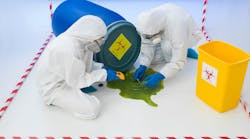If you are involved in a manufacturing or any other business with a stationary process that can result in the accidental release of hazardous substances, you now have a whole new set of requirements for reporting chemical releases, mandated by a federal agency that few Americans are aware even exists.
On Feb. 21, the U.S. Chemical Safety and Hazard Investigation Board (CSB) adopted its final regulation requiring the reporting of certain accidental releases by business. The rule’s declared purpose is to help the board more quickly determine which incidents it should investigate.
The kinds of emissions covered by the new rule is defined as those coming from a stationary source (not a vehicle, such as a tanker truck or railcar), into the ambient air that causes the death or the in-patient hospitalization of any person (not just an employee), or more than $1 million in property damage.
The new rule will go into effect on March 22, but the CSB said that for the first full year it will refrain from referring violations to the Environmental Protection Agency (EPA) for enforcement—unless it learns of what it terms “a knowing failure to report.”
Fully operational since 1998, the CSB was created by Congress in 1990 by the Clean Air Act as an independent federal agency charged with investigating industrial chemical accidents. It is a completely independent agency and operates in a manner similar to the National Transportation Safety Board.
The rule had a difficult birth, but one that is not too surprising for the denizens of Washington, D.C. Congress ordered the board to create such a reporting process in 1990, but the agency didn’t get around to announcing an advanced notice of proposed rulemaking until 2009. The CSB then dragged its feet until 2019 when a federal judge ordered it to issue a proposed rulemaking and then not take any longer than a year to issue a final rule. It got there just under the wire.
Reacting to comments submitted after the rule proposal was announced, the final version changes the length of the reporting period and the definition of a “serious” injury that would trigger the reporting obligation. While the proposed version would have required reporting within four hours, the final version lengthens the period to eight hours.
In spite of the CSB’s promise that it will not be referring reporting violations for enforcement for the first year, “facilities should move quickly to integrate this new reporting scheme into existing release reporting compliance programs,” including training relevant personnel in the reporting requirements, warn attorneys Peter Gray and Amy Symonds of the law firm of Crowell & Moring.
They also stress that the difficulty of such an integration effort should not be underestimated because of the different terminology employed under programs like the emergency release notification requirement imposed by the Emergency Planning and Community Right-to-Know Act (EPCRA) and the release reporting requirements in the Comprehensive Environmental Response, Compensation and Liability Act (CERCLA).
Within eight hours of an accidental release of an “extremely hazardous substance” the facility owner or operator must notify and submit a report to CSB either by e-mail or telephone. The regulation describes an “extremely hazardous substance” as any substance that can cause death, serious injury or substantial property damage.
The CSB defines an owner or operator as including any person or entity that owns, leases, operates, controls or supervises a stationary source. An extremely hazardous substance includes, but is not limited to, chemicals included on EPA’s list of regulated substances under its Risk Management Program (RMP) regulations.
The CSB also acknowledges that situations may arise when a facility owner or operator may be unable to report an accidental release within the required eight hours and states that it will consider a long-term approach to these “unique situations.”
If a facility has already reported the release to the National Response Center (NRC), in accordance with another emergency release notification scheme such as CERCLA, the facility may satisfy its CSB reporting obligation by submitting its NRC identification number to the board. The facility, however, must submit its NRC identification number within 30 minutes of submitting a report to the NRC.
An owner or operator of the stationary source may revise or update information reported to the NRC or the CSB without penalty within 30 days of the report’s submission, or up to 90 days after submitting the report if it can be explained why the revisions could not have been submitted within the first 30 days.
The CSB may forward suspected violations of the reporting rule to the EPA administrator for enforcement. Penalties for failure to make a required report after an accidental release may include administrative penalties, civil actions or criminal actions. However, Gray and Symonds note that the new rule does not identify the size of the penalty that EPA may end up imposing for these kinds of violations.
Detailed information on exactly how businesses should report spills is contained in the CSB’s final rule announcement.

